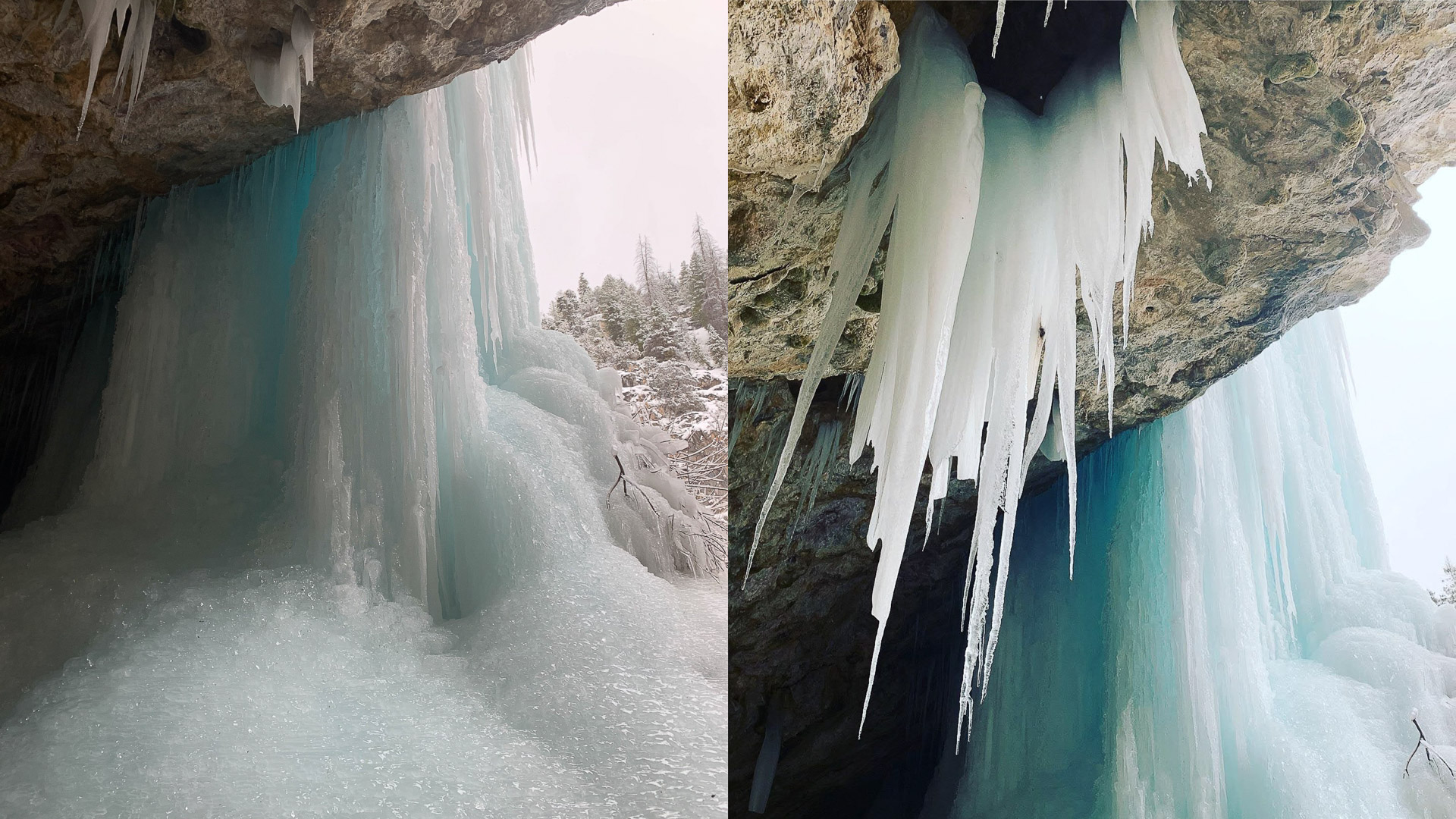
A wondrous display of nature, ice caves are natural caves formed in lava tubes or in limestone. In the West, some of these caves make their annual appearance in the winter months, while others can be visited year-round. Here are some of the ice caves you can visit for an adventure that stimulates the natural senses.
Bandera Volcano – Grants, New Mexico
Take a self-guided tour of the “land of fire and ice” by visiting the Bandera Volcano and Ice Cave. The Ice Cave, a collapsed lava tube, stays at a temperature of 31 degrees year-round. With a 20-foot-thick mass of ice, the cave has been forming and changing for over 3,000 years.
The trail to the cave is an easy 1/4 mile. The 1/2-mile hike to the volcano, which erupted some 10,000 years ago, takes you to the best vantage point after a short climb. Do some gem mining while you are visiting. Open 9 a.m. to 6 p.m. year-round, the general admission rate is $12 per person for visitors ages 13 and up. For children ages 5 to 12, admission is $6 per child, and children under 5 are free. There is lodging on-site, including tent sites, RV sites and cabin rentals.
Big Four Ice Caves – North Cascades, Washington
Caves formed from under an avalanche chute, the Big Four Ice Caves are a popular attraction close to Seattle. The shadow of Big Four Mountain keeps the north face under ice, creating the caves. The hike to the caves is 2.3 miles round trip on crushed gravel and boardwalk winding through marsh and past the site of an old hotel. Just a chimney remains, but the site is perfect for a picnic. Through the forest, the sounds and sights of waterfalls will greet you as you arrive at the ice caves. Bring your leashed pup on this hike to enjoy the scenery alongside you.
Because of snow melt and high avalanche danger, these caves need to be enjoyed from afar. There is a $5 per day use fee. Note: The hiking bridge over the South Fork Stillaguamish River was removed because of the threat of collapsing. The bridge is scheduled to be reinstalled in 2022. Crossing the river on foot is not recommended due to the high and swiftly moving waters, along with rocky footing.

Grottos Trail – Aspen, Colorado
Before you reach the town of Aspen off Independence Pass, there is the 0.6-mile Grottos Trail. The short trail is good for all ages, with multiple stops along the way, including the erratics — two boulders that are trapped on a knoll of granite. These large stones were left behind by a glacier that melted about 18,000 years ago. The cascades of the Roaring Fork River are an additional stop along the trail. Enjoy the sound of the rushing water before making your way back to the trailhead.

The ice caves contain ice year-round and require a rocky descent into the grotto. The walls are smooth and the floor of the cave may be icy, depending on recent thawing and weather. If visiting in late spring or summer, expect to get wet as the ice melts around you. The grotto was once used by the Utes for storing food in a cold environment. Your leashed pup can go with you on this hike. There is a small parking lot that gets crowded, especially on weekends.
Guler Ice Caves – Trout Lake, Washington
Once serving as a major ice supplier for the state, the Guler Ice Caves were also used by early pioneers to store food and foraged berries. The lava tubes are 650 feet long and stay about 32 degrees year-round. Frozen stalactites hang down from the ceiling as you make your way through the four sections of the caves. If conditions are right, you may see the cave shimmer and sparkle. Called the “Crystal Grotto,” the effect is caused by fungi and bacteria.
Visit in early spring to see the most ice, including an ice-covered floor. There is a 20-foot staircase down into the cave. You can drive and park near the cave in the nonwinter months. There is a $5 fee to park. From December to the end of March, you can snowshoe, ski or hike to the cave for 2 miles round trip from Atkisson Sno-Park. You will need to purchase a permit.
Ice Caves Trail – Moore, Montana
Found within the Big Snowy Mountains, the 11-mile round-trip Ice Caves Trail offers a lot to see on one trail. The Devil’s Chute, also a cave; Grandview Point, where you are treated to views of the Snowies; the Grand Teton Range to the south; and even the provinces of Saskatchewan and Alberta in the northeast on a clear day are highlights. But, the ice cave is the real showstopper along the route. You have to earn your views on this trail, but the switchbacks help you navigate the over 2,000 feet of elevation gain.
The approximately 100-foot-wide cave can be accessed year-round, with the right footwear and gear needed in the snowy months. Ice is present year-round, making it a perfect cool-down place in the summer. Seeping water makes the floor slippery and constantly covered in ice. Leashed dogs can enjoy this hike through the Big Snowy Mountains.

Mendenhall Glacier Ice Caves – Juneau, Alaska
Accessible from the West Glacier Trail, the Mendenhall ice caves are best seen by hiring a guide. These blue caves are found inside the 12-mile-long Mendenhall Glacier. The caves are constantly changing, but the blue hue continues to mesmerize visitors. With proper gear, the caves can be visited by making a 4.5-mile trek on the West Glacier or with a 5-mile trip via canoe/kayak.
Caves that once existed are no longer there, while new caves have formed. That is why booking a tour/guide is recommended for finding the best and safest way to see this natural phenomenon. The tours generally run from July to September.

Rifle Ice Caves – Rifle, Colorado
Located within Rifle Mountain Park, these ice caves form in the winter months between December and February, weather permitting. Visitors may be able to see ice even through June, depending on temperature. Be sure to wear your spikes on this adventure, as there are four ice caves to be explored within the park: Ice Palace, Soul on Ice, Stone Tree and the Final Curtain. A 3/4-mile round-trip hike on the Koper’s Trail will take you to the Ice Palace and Final Curtain caves. The blue hue of the Ice Palace will make you think you are in the movie Frozen, while the Final Curtain takes some crawling to get into and out of. Most hikers decide to skip the Soul on Ice and Stone Tree caves as they are smaller. These caves are located down the same trail and are worth exploring if you want to see more incredible ice features.

Be sure to look up as you make your way from one cave to the next. The area is also popular with ice climbers. There is a $5 parking fee to visit the caves. Leashed dogs are welcome to visit the caves.
Shoshone Ice Caves – Shoshone, Idaho
Open seasonally from May to September, the Shoshone Ice Caves can be visited by a guided tour leaving every hour. A historic, leisurely 3/4-mile path through the lava fields, 80 stairs and a suspension bridge take you 100 feet below the 4.5-mile-long lava tube created some 24,000 years ago. The ice was once trucked all the way to the Oregon coast for use in iceboxes. The ice caves have been restored over the years with the creation of man-made walls and feature ice 17 feet thick in places.
Also used by the Olympic speed skaters in the early 1900s for year-round training, the caves stay 28 degrees year-round. Admission fees are $12 for adults; $8 for kids ages four to 12; and children under four get in free.






